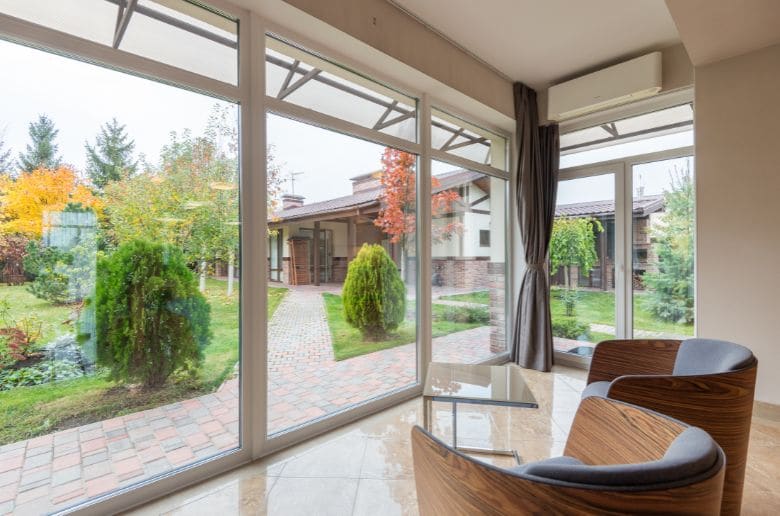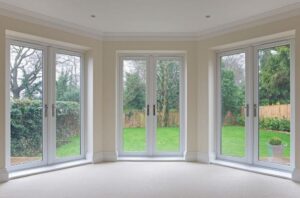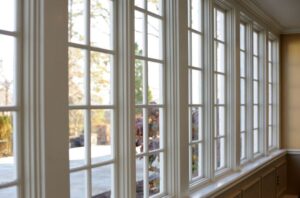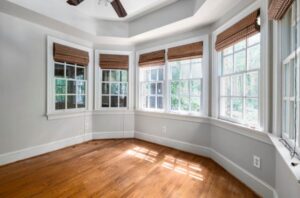In the quest to find the perfect windows for your home, the choice often comes down to two renowned brands: Alliance Windows vs Pella.
Both offer unique benefits, but how do they really stack up against each other?
Selecting the right window brand is more than just a matter of style—it’s about comfort, efficiency, and value for your investment.
This article will delve into a comprehensive comparison of Alliance and Pella windows, evaluating their materials, styles, energy efficiency, and more.
We’ll guide you through the key aspects to consider, helping you make an informed decision on which brand best suits your needs.
Let’s begin by exploring what each brand has to offer.
Alliance Windows vs Pella Comparison Table
| Feature | Alliance Windows | Pella Windows |
|---|---|---|
| Materials Offered | Vinyl, Wood, Fiberglass, Aluminum-Clad | Vinyl, Wood, Fiberglass, Aluminum-Clad |
| Window Styles | Basic Styles: Double-Hung, Sliders, Casements | Wide Variety: Architectural Styles |
| Glass Options | Low-E, Tinted, Laminated, Argon Fill | Advanced Low-E, Clean-Coating, Sunlight Block, plus all Alliance options |
| Energy Efficiency | Excellent ratings | Slightly higher than Alliance |
| Noise Reduction | Good with Laminated Glass | Good with Laminated Glass |
| Security Features | Fiberglass, Laminated Glass | Impact-Resistant Glass |
| Cost | Moderate, budget-friendly | Premium pricing, higher costs |
| Warranties | Limited Lifetime | 10-20 years Comprehensive (Wood), Lifetime Limited (Others) |
| Manufacturer Type | Mass-Market, Competitively Priced | Premium, High-End, Luxury |
| Pros | Competitive pricing, energy efficiency, variety of materials | Premium quality, extensive styles, energy efficiency |
| Cons | Limited design options, shorter warranty | Higher cost, variable warranty terms |
| Key Differences | Multi-chambered vinyl windows; no wood windows | Foam-filled vinyl windows, high-end wood windows |
| Performance | Good energy efficiency, noise reduction, and structural integrity | Slightly better in energy efficiency, advanced security features |
Comparing Materials and Styles
When selecting windows for your home, understanding the materials and styles available is crucial.
Both Alliance Windows vs Pella offer a range of options, but their offerings differ significantly in certain aspects.
Overview of materials offered by both brands
Alliance and Pella both provide a variety of materials, including Vinyl, Wood, Fiberglass, and Aluminum-Clad.
This selection ensures that regardless of your preference or architectural requirements, there’s likely a material that fits your needs.
However, the quality and specific characteristics of these materials can vary between the two brands.
- Vinyl: Known for its durability and low maintenance.
- Wood: Offers a classic look with natural insulating properties.
- Fiberglass: Renowned for its strength and energy efficiency.
- Aluminum-Clad: Combines the beauty of wood with the resilience of aluminum.
Window style options: Basic vs. Architectural
The window styles available from Alliance and Pella cater to different aesthetic preferences and functional needs.
Alliance focuses on basic styles, such as Double-Hung, Sliders, and Casements. These options are practical and fit well in a variety of architectural settings.
In contrast, Pella offers a wider variety of designs, including architectural styles that bring a unique flair and customization possibilities to your home.
- Alliance: Ideal for straightforward, functional window needs.
- Pella: Best for those seeking more decorative and bespoke options.
Assessing aesthetic appeal and design versatility
When it comes to the aesthetic appeal and design versatility, Pella generally takes the lead due to its extensive range of design options. The brand is known for offering windows that can be tailored to the specific style and character of your home.
On the other hand, Alliance, while offering a good range of designs, may not match the extent of customization and variety that Pella provides.
- Alliance: Offers a solid range of options suitable for most homes.
- Pella: Excels in providing windows that can be personalized to a greater extent, enhancing the aesthetic appeal of your property.
Important Note: While choosing between Alliance and Pella, consider not only the current appearance of your home but also any future renovations or style changes. The versatility and adaptability of the window style can impact your home’s look and feel for years to come.
In conclusion, both Alliance and Pella offer quality materials and styles, but their offerings cater to different needs and preferences. Pella stands out in terms of design versatility and aesthetic options, while Alliance offers practical and functional window solutions.
Your choice should align with your home’s architectural style, personal preference, and long-term plans for your property.
Energy Efficiency and Glass Technology
The battle between Alliance Windows vs Pella in the realm of energy efficiency and glass technology is a crucial aspect for homeowners.
Let’s delve into how these two brands compare in this domain.
Comparison of energy efficiency ratings
Both Alliance and Pella windows are recognized for their excellent energy efficiency. They feature insulated glass and tight seals, crucial for maintaining indoor temperature and reducing energy costs.
However, Pella has a slight edge with its slightly higher energy efficiency ratings. This difference, though marginal, can be significant for those looking to maximize energy savings over time.
- Alliance: Excellent energy efficiency.
- Pella: Slightly higher efficiency ratings than Alliance.
Glass options: Standard and Exclusive features
When it comes to glass options, both brands offer Low-E, Tinted, Laminated, and Argon-filled glasses.
These options contribute significantly to the windows’ overall energy efficiency and UV protection. Pella, however, steps ahead with exclusive features like Advanced Low-E, Clean-Coating, and Natural Sunlight Blocking technologies.
These advanced options can provide enhanced energy efficiency and additional benefits, such as reduced cleaning needs and improved UV protection.
- Shared Options: Low-E, Tinted, Laminated, Argon Fill.
- Pella Exclusive: Advanced Low-E, Clean-Coating, Natural Sunlight Block.
Impact of glass technology on energy bills and comfort
The choice of glass technology in your windows can have a significant impact on both your energy bills and overall comfort within your home.
High-performance glass options, like those offered by Pella, can lead to more substantial energy savings and a more comfortable indoor environment. They achieve this by better regulating indoor temperatures and reducing the load on heating and cooling systems.
Important Note: Consider the climate you live in when selecting glass options. Advanced features like those offered by Pella may be more beneficial in regions with extreme temperatures.
In summary, while both brands offer high-quality energy-efficient options, Pella provides a slight advantage with its higher efficiency ratings and exclusive glass technologies.
These factors can contribute to long-term savings and enhanced indoor comfort, making them an important consideration for any homeowner.
Key Differences Between Alliance Windows and Pella Windows
Unraveling the key differences between Alliance and Pella windows is essential for homeowners making an informed choice.
Let’s dive into the unique aspects of each brand.
Distinguishing features of vinyl and wood windows
The vinyl windows from both brands offer durability and low maintenance, but with distinct features. Alliance provides multi-chambered vinyl windows, focusing on thermal efficiency and cost-effectiveness.
Pella, on the other hand, offers foam-filled vinyl frames with fusion-welded corners, enhancing energy efficiency and structural integrity.
- Alliance Vinyl Windows: Multi-chambered for better insulation.
- Pella Vinyl Windows: Foam-filled frames for enhanced energy efficiency.
When it comes to wood windows, Pella stands out as Alliance does not offer this option. Pella’s wood windows are known for their high-end craftsmanship, offering a luxurious look and feel with superior durability.
Fiberglass and aluminum window comparison
In the realm of fiberglass and aluminum windows, both brands bring robust and efficient options to the table. Alliance’s fiberglass windows are praised for their strength and energy efficiency.
However, Pella takes it a step further by mimicking the painted wood look, giving homeowners the aesthetic appeal of wood with the durability of fiberglass.
Both brands offer aluminum-clad wood windows, but Pella’s version features heavy-duty cladding, enhancing the durability and weather resistance.
- Fiberglass Windows: Alliance’s focus on strength; Pella’s mimicry of wood aesthetics.
- Aluminum Windows: Both offer aluminum-clad options; Pella with heavy-duty cladding.
Unique selling points of each brand
Alliance and Pella each have their unique selling points that cater to different homeowner needs.
- Alliance: Known for its competitive pricing and energy-efficient designs, Alliance is ideal for those looking for budget-friendly options without compromising on quality.
- Pella: Pella’s reputation as a premium, high-end brand shines through its extensive customization options, advanced glass features, and higher energy efficiency ratings. It’s a go-to for those seeking luxury and bespoke window solutions.
Important Note: Your choice between Alliance and Pella should be influenced by your specific needs, budget, and the desired aesthetic for your home. Each brand has its strengths, and the right choice depends on what aspects of window design and functionality are most important to you.
Which is Better? Evaluating Performance and Cost
Deciding between Alliance windows vs Pella windows involves a careful evaluation of performance and cost.
Let’s break down these crucial aspects to help you make a well-informed decision.
Analyzing performance metrics: Energy efficiency and noise reduction
Both brands boast excellent energy efficiency, with Pella slightly outperforming Alliance. This difference, though small, can contribute to long-term energy savings.
When it comes to noise reduction, both brands offer comparable performance, especially with their laminated glass options.
- Energy Efficiency: Pella has a slight edge over Alliance.
- Noise Reduction: Comparable performance for both brands.
Cost comparison: Budget-friendly vs. premium pricing
The cost is a significant factor in the decision-making process. Alliance is known for its moderate pricing, making it a more budget-friendly option.
Their vinyl and fiberglass models are particularly cost-effective, being 30-50% less expensive than comparable models. Pella, positioned as a premium brand, reflects higher pricing, especially for their wood windows.
- Alliance: More affordable, suitable for budget-conscious buyers.
- Pella: Premium pricing, aligned with its luxury brand positioning.
Weighing the pros and cons for different buyer needs
Choosing the right brand depends on individual needs and preferences:
- Alliance:
- Pros: Cost-effective, energy-efficient, variety in materials.
- Cons: Limited design options, shorter warranty period.
- Pella:
- Pros: Premium quality, wide range of styles, high focus on energy efficiency.
- Cons: Higher cost, variable warranty terms.
Important Note: Consider your long-term goals and immediate needs. Are you looking for more affordable, functional windows, or are you willing to invest in premium, customizable options? Your answer to this will guide your choice between Alliance and Pella.
In conclusion, while Alliance offers a more budget-friendly solution with decent performance, Pella excels in providing a wider range of styles and slightly better energy efficiency, albeit at a higher cost.
The decision ultimately hinges on balancing your budget with your desired window features and performance expectations.
Conclusion and Recommendations
In this comprehensive comparison between Alliance Windows vs Pella, we’ve highlighted key differences in materials, styles, energy efficiency, and cost.
Alliance offers affordability and functional efficiency, making it suitable for those on a budget. Pella, conversely, excels in premium quality and customization, ideal for those seeking luxury and specific design needs.
Ultimately, the decision rests on balancing personal preferences with practical considerations.
As a buyer, your choice should align with your home’s architectural style and your long-term satisfaction, ensuring that the windows you select not only complement your home but also cater to your lifestyle and budget needs.





